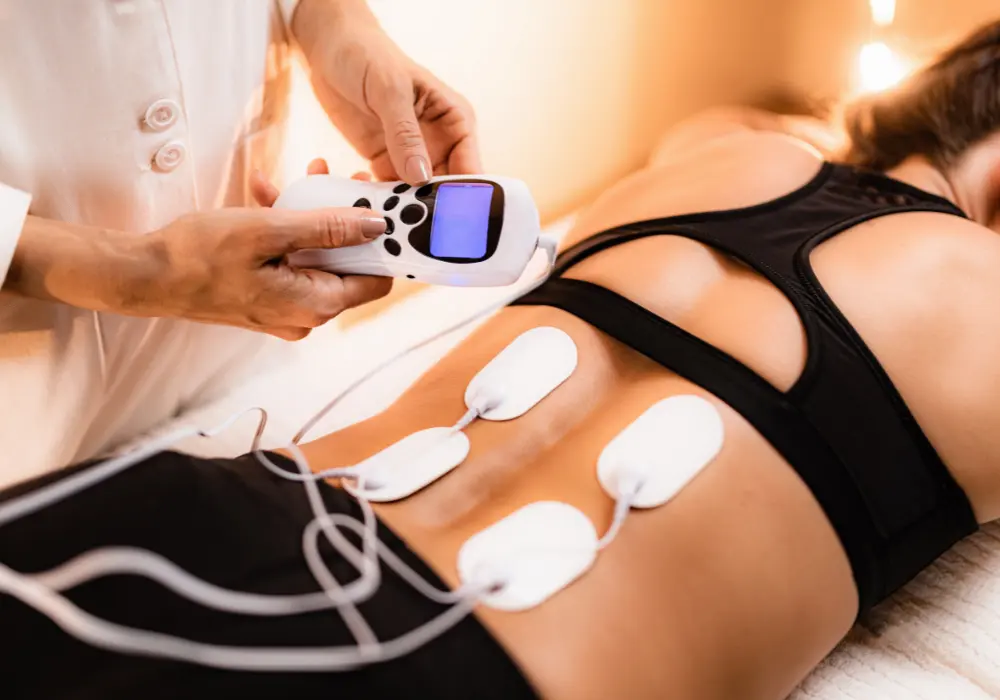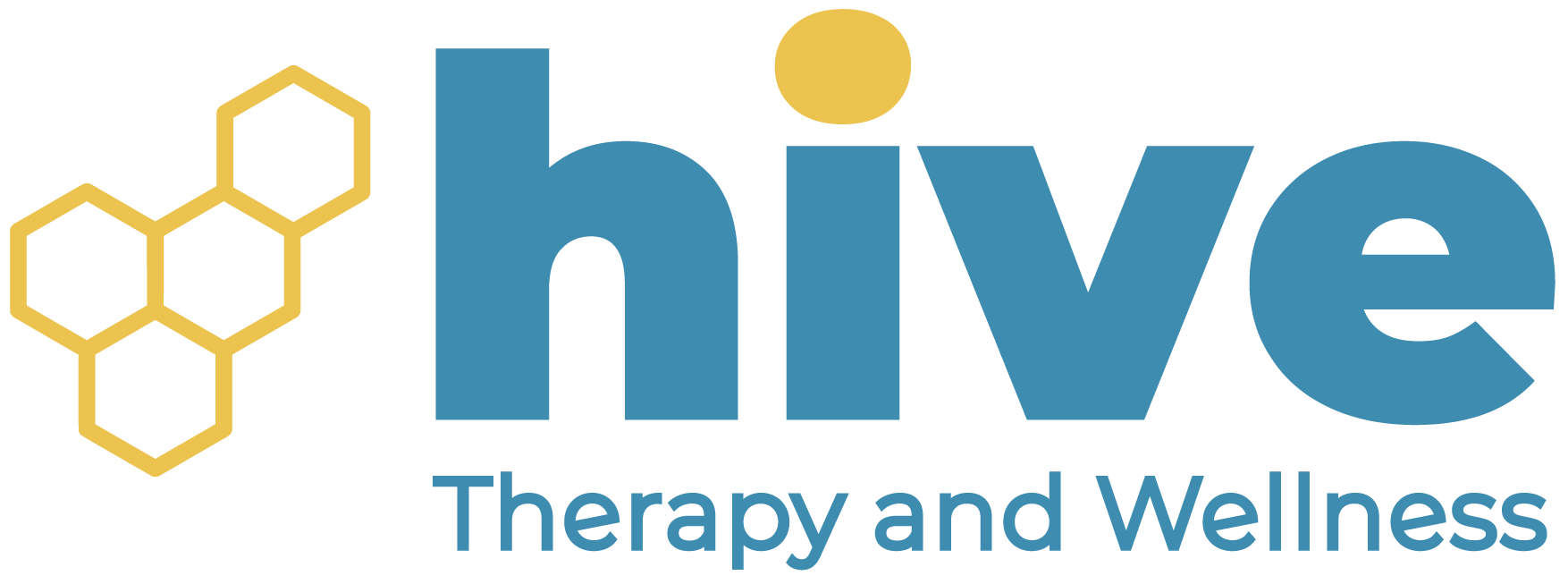Electrical Muscle Stimulation
Electrical Muscle Stimulation
Empowering Movement, Restoring Freedom
Schedule a FREE Discovery Call!
Electrical impulses are sent into the tissue to improve the brain’s response to the targeted area.
What Is Electrical Muscle Stimulation?
Electrical muscle stimulation (known as EMS or “E-stim”) is a physical therapy treatment that creates electrical activity in a targeted area. This form of treatment is used for a variety of conditions, and offers a lot of benefits such as relieving pain and improving muscle strength.
Although the usage of the word “electrical” can seem intimidating, the electrical activity is set at a safe and tolerable level, which is controlled by the physical therapist and/or patient.

The needs of the patient help determine the method of electrical muscle stimulation; here are some of the different types:
- Transcutaneous Electrical Nerve Stimulation (TENS)
- Involves placing sticky pads superficially on a patient’s skin or using a probe internally (vaginally or rectally). This method of E-stim is especially helpful for pain management, as it blocks pain signals that are sent to the brain. Some patients may even experience relief for some time after receiving this treatment.
- Neuromuscular Electrical Stimulation (NMES)
- This treatment focuses more on strengthening a muscle by activating the motor neuron. This is especially useful after surgery, as patients may need extra help getting the nerves and muscles around a surgical site to activate. This type of E-stim is used to help retrain muscle function through contraction and relaxation, as well as increase the overall range of motion.
- Similarly to TENS, this method also involves the use of sticky pads as a means of sending the electrical activity to the treatment area.
- Electrical Stimulation With Dry Needling
- When used simultaneously with dry needling, electrical muscle stimulation can be beneficial for a variety of reasons. It can be used to: encourage strengthening of a muscle, help induce relaxation, decrease muscle tone, control pain, and aid in recovery by removing toxins from the tissues after vigorous exercise. Using E-stim during dry needling also allows the physical therapist to tailor the treatment more closely to the patient’s needs and goals while minimizing post treatment soreness.
Who Can Benefit From E-Stim?
E-stim can be used to improve the strength of a muscle, decrease pain, and improve the brain’s response and interaction with the target treatment area. This is done by targeting an area of muscles and nerves. By affecting the nerves, electrical muscle stimulation can be used for pain management and relief. When targeting muscles, E-stim can be used to help muscles contract and relax; essentially retraining the muscle’s motor functions—which is a great application following a surgery or injury.
Electrical muscle stimulation can be utilized for many different conditions, and is frequently used in conjunction with other physical therapy treatments. Patients who have experienced an acute injury, have chronic pain, or are recovering from surgery often receive electrical muscle stimulation as part of their treatment. This includes those who have had joint replacements, ACL repairs, C-sections, or back surgery.
E-stim is a treatment that can be performed both in the office by a physical therapist or, in other cases, at home by the patient. This makes it a great option for independent pain treatment outside of the patient’s physical therapy care plan.
What to Expect From Electrical Muscle Stimulation
Certain conditions may be contraindicated for electrical muscle stimulation, such as patients with implanted electronic devices (pacemakers, etc). Your physical therapist will always be sure to screen for any possible contraindications before performing any E-stim treatment. They will also make sure to fully explain the process and possible benefits of electrical stimulation for your condition, and request full consent before beginning your treatment.
As for the actual process and what it may feel like, electrical muscle stimulation is a safe treatment that uses electrical activity at controlled, tolerable levels. For many, it can provide great pain relief. However, each type of electrical muscle stimulation is slightly different, therefore you may have a different experience depending on the type of treatment used.
- When Using TENS:
- TENS treatments may be done in the office or at home, utilizing either sticky pads or internal probes. This treatment utilizes the gate control theory for pain management. This theory proposes the spinal cord contains a neurological “gate” that either blocks pain signals or allows them to continue on to the brain.
- Patients may feel a tingling or buzzing sensation at the location of the stimulation, but it should not be painful. This non-painful input “closes” the gates to painful input, which prevents pain sensation from traveling to the central nervous system (it suppresses pain).
- When Using NMES:
- NMES also uses the sticky pads, but it has the purpose of facilitating a muscle contraction which may feel like a small twitch or a cramp-like sensation. It is adjusted based on patient tolerance. Its purpose is to recruit as much of the muscle fibers as possible, which helps the neuromotor connection to be more efficient and facilitate a stronger muscle contraction. Similarly to TENS, this treatment may be done in the office or at home as directed by your therapist.
- When Using E-stim With Dry Needling:
- This type of treatment can only be done in the office by a physical therapist, as it involves placing needles into the skin (a minimally invasive procedure) while attaching clips that deliver the E-stim current. It can achieve both of the above-described goals, resulting in muscle activation and pain management.
- Additionally, this treatment can be used for recovery purposes as well. Although some patients may report a buzzing or “sparkly” sensation at the site of the needle (which can be titrated out with a small adjustment on the E-stim unit), the goal is to elicit a twitch and muscle pumping response. This helps to increase blood flow and remove chemical irritants or toxins from the targeted area. Check out our dry needling page for more information.
Electrical muscle stimulation (known as EMS or “E-stim”) is a physical therapy treatment that creates electrical activity in a targeted area. This form of treatment is used for a variety of conditions, and offers a lot of benefits such as relieving pain and improving muscle strength.
Although the usage of the word “electrical” can seem intimidating, the electrical activity is set at a safe and tolerable level, which is controlled by the physical therapist and/or patient.
The needs of the patient help determine the method of electrical muscle stimulation; here are some of the different types:
- Transcutaneous Electrical Nerve Stimulation (TENS)
- Involves placing sticky pads superficially on a patient’s skin or using a probe internally (vaginally or rectally). This method of E-stim is especially helpful for pain management, as it blocks pain signals that are sent to the brain. Some patients may even experience relief for some time after receiving this treatment.
- Neuromuscular Electrical Stimulation (NMES)
- This treatment focuses more on strengthening a muscle by activating the motor neuron. This is especially useful after surgery, as patients may need extra help getting the nerves and muscles around a surgical site to activate. This type of E-stim is used to help retrain muscle function through contraction and relaxation, as well as increase the overall range of motion.
- Similarly to TENS, this method also involves the use of sticky pads as a means of sending the electrical activity to the treatment area.
- Electrical Stimulation With Dry Needling
- When used simultaneously with dry needling, electrical muscle stimulation can be beneficial for a variety of reasons. It can be used to: encourage strengthening of a muscle, help induce relaxation, decrease muscle tone, control pain, and aid in recovery by removing toxins from the tissues after vigorous exercise. Using E-stim during dry needling also allows the physical therapist to tailor the treatment more closely to the patient’s needs and goals while minimizing post treatment soreness.
E-stim can be used to improve the strength of a muscle, decrease pain, and improve the brain’s response and interaction with the target treatment area. This is done by targeting an area of muscles and nerves. By affecting the nerves, electrical muscle stimulation can be used for pain management and relief. When targeting muscles, E-stim can be used to help muscles contract and relax; essentially retraining the muscle’s motor functions—which is a great application following a surgery or injury.
Electrical muscle stimulation can be utilized for many different conditions, and is frequently used in conjunction with other physical therapy treatments. Patients who have experienced an acute injury, have chronic pain, or are recovering from surgery often receive electrical muscle stimulation as part of their treatment. This includes those who have had joint replacements, ACL repairs, C-sections, or back surgery.
E-stim is a treatment that can be performed both in the office by a physical therapist or, in other cases, at home by the patient. This makes it a great option for independent pain treatment outside of the patient’s physical therapy care plan.
Certain conditions may be contraindicated for electrical muscle stimulation, such as patients with implanted electronic devices (pacemakers, etc). Your physical therapist will always be sure to screen for any possible contraindications before performing any E-stim treatment. They will also make sure to fully explain the process and possible benefits of electrical stimulation for your condition, and request full consent before beginning your treatment.
As for the actual process and what it may feel like, electrical muscle stimulation is a safe treatment that uses electrical activity at controlled, tolerable levels. For many, it can provide great pain relief. However, each type of electrical muscle stimulation is slightly different, therefore you may have a different experience depending on the type of treatment used.
- When Using TENS:
- TENS treatments may be done in the office or at home, utilizing either sticky pads or internal probes. This treatment utilizes the gate control theory for pain management. This theory proposes the spinal cord contains a neurological “gate” that either blocks pain signals or allows them to continue on to the brain.
- Patients may feel a tingling or buzzing sensation at the location of the stimulation, but it should not be painful. This non-painful input “closes” the gates to painful input, which prevents pain sensation from traveling to the central nervous system (it suppresses pain).
- When Using NMES:
- NMES also uses the sticky pads, but it has the purpose of facilitating a muscle contraction which may feel like a small twitch or a cramp-like sensation. It is adjusted based on patient tolerance. Its purpose is to recruit as much of the muscle fibers as possible, which helps the neuromotor connection to be more efficient and facilitate a stronger muscle contraction. Similarly to TENS, this treatment may be done in the office or at home as directed by your therapist.
- When Using E-stim With Dry Needling:
- This type of treatment can only be done in the office by a physical therapist, as it involves placing needles into the skin (a minimally invasive procedure) while attaching clips that deliver the E-stim current. It can achieve both of the above-described goals, resulting in muscle activation and pain management.
- Additionally, this treatment can be used for recovery purposes as well. Although some patients may report a buzzing or “sparkly” sensation at the site of the needle (which can be titrated out with a small adjustment on the E-stim unit), the goal is to elicit a twitch and muscle pumping response. This helps to increase blood flow and remove chemical irritants or toxins from the targeted area. Check out our dry needling page for more information.


